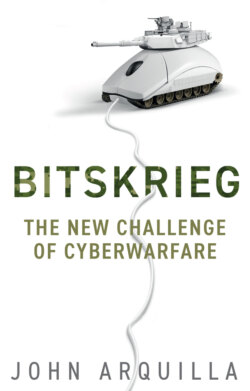Читать книгу Bitskrieg - John Arquilla - Страница 12
Rise of the intelligent machines of war
ОглавлениеAnother technological aspect of cyberwar – an especially “cool” one – has to do with the rise of robots – or, more delicately put, artificial intelligence (AI). These machines, devices, and their software are the ultimate cyber tools, embodying the principles of control-through-feedback that Norbert Wiener envisioned. Back in the 1950s, he thought of the “human use of human beings.” Today, we should be thinking about the “human use of artificial beings.” In cyberspace, there is already much use of automation, by many countries, where bots have the authority to move swiftly on their own to counter attacks on information systems they are tasked with defending. The pace of cyberspace-based attacks is often too fast for humans to detect, track, and disrupt. On the more proactive side, there is widespread use of information-gathering AI “spiders” and other searchers – though the world’s more democratic societies have strived to impose at least some limits on the use of such capabilities. And when it comes to employing bots in physical battle, those same liberal societies have regarded the matter as close to abhorrent, demanding almost always to keep a “human in the loop” for purposes of control. There is even an effort to ban the development of “killer robots,” which has been championed at the United Nations and by many non-governmental organizations. Secretary-General António Guterres put the matter very starkly at a “web summit” held in late 2018:
Machines that have the power and the discretion to take human lives are politically unacceptable, morally repugnant, and should be banned by international law.48
Guterres’s speech buttressed the position of the 25 nations and the Holy See that had already signed on to the call to ban killer robots – and two more nations joined shortly after he spoke. However, as of this writing (2020), no NATO member states have supported such a prohibition on “Lethal Autonomous Weapons Systems” (LAWS); nor have the Russians. As to China, its position is to call for no first use of such weapons, but still to allow for their development and production. Interestingly, quite a few in the scientific and high-tech commercial sectors have embraced efforts to prevent the rise of military robotics. In 2015, 1,000 experts in AI signed an open letter expressing their opposition. At the same time, luminaries such as Stephen Hawking and Elon Musk took the position that the rise of robots, if allowed, could “spell the end of the human race.”49 This alarmist view has been articulated over the past several decades, the jumping-off point in popular culture probably being the 1984 film The Terminator. The Matrix movies and the re-booted television series Battlestar Galactica that came later both reinforced this trope, completely overshadowing Isaac Asimov’s pacifistic “Laws of Robotics” – which he introduced in 1942, but about which even he wrote with ambivalence.
Around the same time that Arnold Schwarzenegger was first terrorizing humanity, scientist/novelist Michael Crichton was articulating the position that
When the super-intelligent machine comes, we’ll survive . . . The fear that in the coming years we will be replaced by our creations – that we will live with computers as our pets live with us – suggests an extraordinary lack of faith in human beings and their enterprise. . . . Our ancestors were threatened by trains and planes and electricity; we take these things for granted. Today we are threatened by computers; our descendants will take them for granted, too.50
Whether the AI alarmists are right will not be known for many decades – probably not for a few centuries. In the meantime, AI will continue to diffuse into virtually all aspects of life, and certainly into military and security affairs. Indeed, given the current trajectory of AI development, it is clear that armies, navies, and aerospace forces will soon be replete with robotics that sense, shoot – perhaps even do some strategizing.51 But at present it seems clear that the patterns of development and diffusion are uneven, with the armed forces of authoritarian states embracing robotics far more actively and broadly than liberal, open societies. China has, in particular, jumped out well ahead in this new arms race, becoming, as one study has put it, an “AI superpower,”52 while the United States – home to world-leading commercial, academic, and governmental research giants in the field – has lagged.
The reasons why the United States and other more open, market-oriented societies have fallen behind in the AI arms race will be explored in the following chapter. As will the policy paths that have led to the grave and ever-increasing vulnerability of individuals, commercial enterprises, government, the military, and other institutions that so powerfully affect society and security, especially in the world’s democracies. It is ironic that the countries of the “free world” – such as it is – should be in dire straits in cyber-related matters, given that liberal polities were so successful over the past century in using advances in information technology to “hack” both fascism and communism. Literally. In World War II, for example, the Allied information edge – enabled by creation of the world’s first true high-performance computers that fueled Britain’s “Ultra” and the American “Magic” – had a profound impact on the outcome of that conflict. Both the German Enigma encryption system and the Imperial Japanese codes were hacked, enabling signal victories even when the material situation was sharply in favor of the aggressor, as at Midway in 1942. Hacks also played huge roles in the Battle of the Atlantic, at Normandy in 1944, and – by sharing informational coups with the Russians – on the all-important Eastern Front.53 The failure of democracies today to craft Cyber-Age versions of Ultra and Magic courts disaster.
